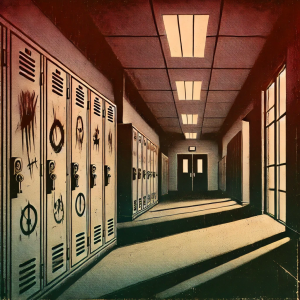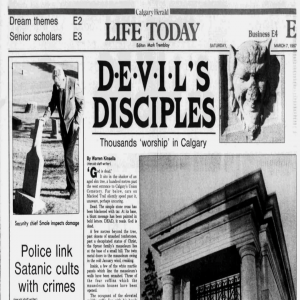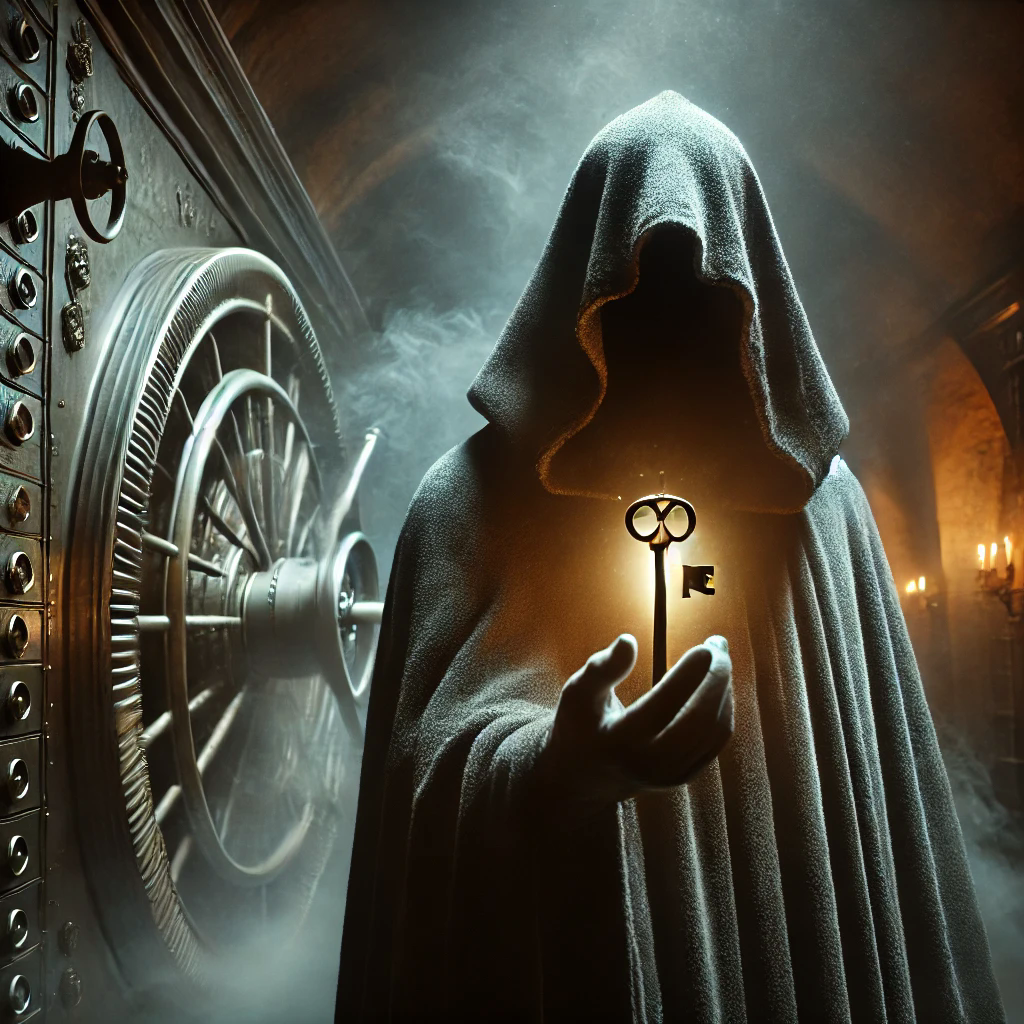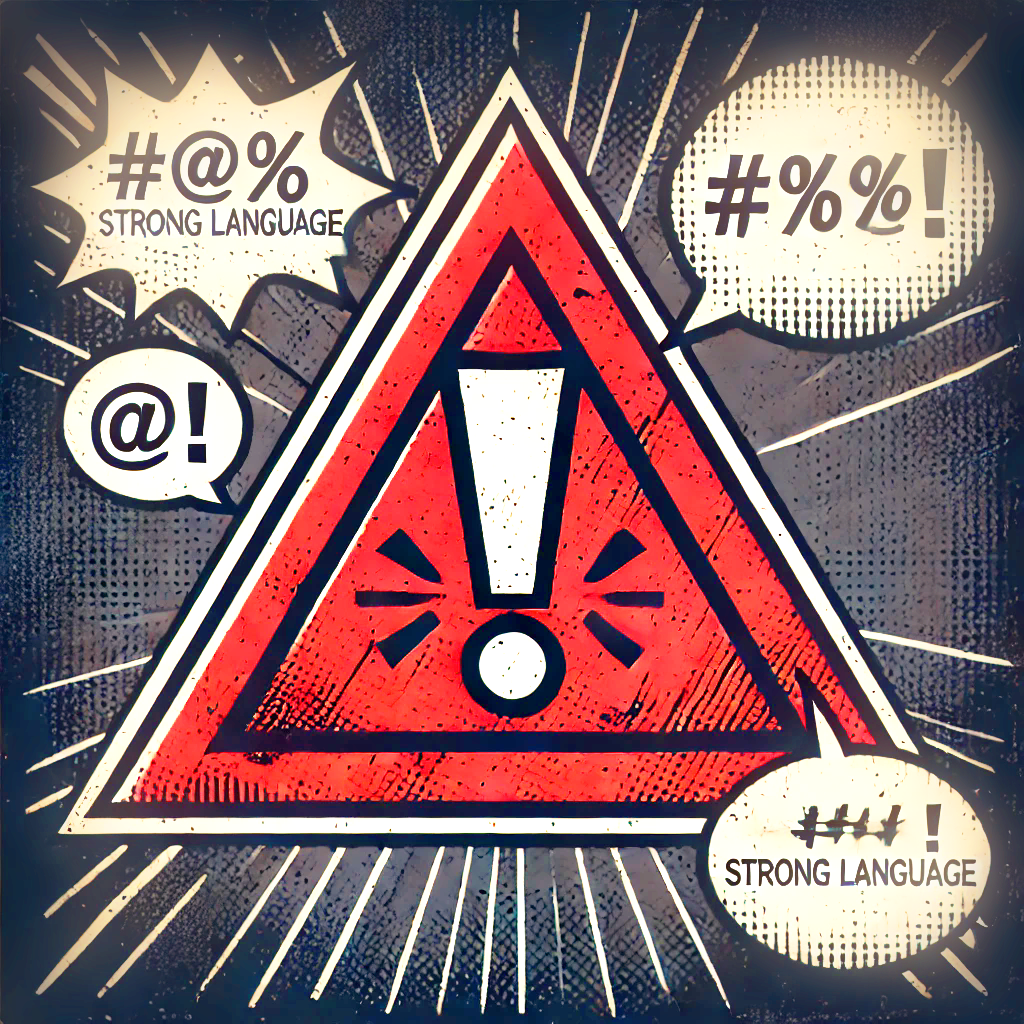Conspiracy theories are the restless phantoms of our cultural consciousness, born from fragments of dread and darkened by suspicion. They slink out from society’s shadows during moments of uncertainty, taking root in our minds as we project anxieties onto barely seen enemies. These theories do not just appear out of thin air; they are shaped by the fears and values of their time, evolving yet retaining an eerie familiarity. Today’s conspiracy theories find echoes in the satanic panic of the 1980s, a period now brought vividly to life in Hysteria!, Peacock’s series that plunges into the heart of one such communal nightmare. The show offers a grim reflection of the terrifying ease with which fear can become reality and suspicion can masquerade as truth. In these stories, we may catch glimpses of ourselves, for every conspiracy reveals more about the society that fears it than about the phantoms it hunts.
Conspiracies do more than haunt—they take hold, leaving dark stains on society’s fabric. From whispers and rumors, they spread, winding through communities, twisting minds, and blurring the lines between truth and fantasy. This is the sinister alchemy of collective fear, where paranoia builds momentum until it consumes everything in its path. Conspiracy theories are not just stories; they are symptoms, strange distortions of our fears that emerge when reality becomes too unsettling to face directly. We call them “theories,” but they are more akin to unholy myths, sustained by the human need to find meaning in chaos. And so we look to the past, to those who suffered under the weight of collective delusion, hoping, perhaps, to break free from the cycle of fear that binds us.
Historical Cycles: From Salem’s Gallows to Satanic Cults

History repeats, and with each repetition, the cast of villains changes but the outcome remains tragically the same. In the 1690s, the Salem witch trials dragged innocents to the gallows based on fevered accusations. In the 1950s, McCarthyism encouraged Americans to look for communists under every rock, creating a culture of mistrust so pervasive that families and communities alike were torn apart. And in the 1980s, the satanic panic took root, a wave of hysteria that painted day-care providers, metal bands, and even children’s toys as tools of dark, supernatural forces. Hysteria! captures the fevered atmosphere of the satanic panic, showing a society so gripped by fear that reason is trampled underfoot. Each of these moral panics speaks to an unwillingness to confront the real forces of change at work, opting instead to blame imagined enemies for what they cannot control.
The cycle is as predictable as it is destructive. At each turn of history’s wheel, society casts out another group to purge itself of fear, projecting darkness onto “outsiders” who are seen as threats to cherished values. The panic of the 1980s, with its satanic cult hysteria, was rooted in anxiety over shifting family dynamics, women entering the workforce, and cultural movements that threatened conservative ideals. By finding scapegoats in heavy metal bands, day-care providers, and anything even remotely “occult,” society could channel its unease into something tangible, something it could vilify. Yet, as Hysteria! reveals, this catharsis comes at a steep cost. Each time we chase phantoms, we wound ourselves, leaving scars that last long after the panic has faded.
Media: The Conduit of Fear
Conspiracy theories may originate in whispers, but it is the media that amplifies them to deafening roars. In the satanic panic of the 1980s, the role of television was paramount, as talk shows and sensational news segments devoted endless hours to stories of ritual abuse, supposed cults, and hidden dangers lurking in small-town America. Geraldo Rivera and other media figures fueled this frenzy, casting unfounded accusations as facts and creating a climate in which mere suspicion could ruin lives. Hysteria! showcases this media spectacle, reminding viewers how easily television can transform unproven fears into seemingly undeniable truths. With every headline and dramatic reenactment, media figures fanned the flames, pushing society further into the darkness of its own imaginings.
Today, social media has taken on this role, accelerating the spread of conspiracy theories to unprecedented speeds. Platforms like Facebook and Twitter become echo chambers, where algorithms reward engagement over truth, pushing more people to fall down rabbit holes of misinformation. Here, in the murky depths of the internet, conspiracy theories find fertile ground to grow unchecked, mutating and spreading across networks that never sleep. Hysteria! serves as a cautionary tale for our digital age, reflecting the dangers that arise when fear is allowed to fester in the media’s glare. In both cases, the media’s reach ensures that a simple rumor can grow monstrous, leaving no corner of society untouched by the resulting panic.
The Outsider, The Elite, and The Otherworldly Enemy

Each generation creates its own “Other,” the shadowy figure onto whom society projects its fears and frustrations. In the 1980s, the satanic panic targeted outsiders in the form of day-care providers, heavy metal musicians, and anyone perceived as strange or unconventional. In Hysteria!, a high school rock band becomes the focal point of suspicion after a local football star’s death, embodying society’s fear of youth culture, rebellion, and the unknown. The town’s need for a villain is insatiable; it doesn’t matter whether the accused are guilty, only that they serve as a vessel for communal anxieties. By casting these figures as “Other,” society reaffirms its own values, finding comfort in the idea that evil exists but is kept at bay.
Today’s conspiracy theories continue to hunt for new “enemies” within, often targeting elites, immigrants, or marginalized communities, whom society blames for undermining its cherished ideals. The narrative remains the same: shadowy forces threaten the social order, and only by unmasking them can the community be saved. This craving for a villain, whether satanic cults in the ’80s or secret cabals today, speaks to something deeper—a need to simplify our fears, to reduce a complex world to a single, terrible threat. Hysteria! reveals the terrifying consequences of this mentality, showing how easily a community can turn on its own in the name of protecting itself. In every conspiracy, the “Other” is less a real person than a reflection of society’s own insecurities and prejudices.
The Comfort of Belief in the Unseen
To believe in a conspiracy theory is to find a certain comfort in darkness, a strange solace in the thought that, behind the chaos, there is a design—however sinister. When faced with uncertainty, some seek clarity, and conspiracy theories offer a seductive solution. They tell a simple story: here is the enemy, here is the plot, here is the reason the world feels out of control. Hysteria! taps into this need for explanation, illustrating how a small town, grieving and confused, seeks answers in shadows. For many, it is less painful to believe in a grand, malevolent scheme than to face the randomness and tragedies of real life.
This craving for clarity is as old as humanity, and conspiracy theories provide a mythic simplicity that can be deeply comforting. They offer answers to the unanswerable, making the world feel just a bit more predictable. But this comfort comes at a cost, as it blinds believers to the truth and drives communities to acts of cruelty in the name of preserving order. In Hysteria!, this drive to simplify reality leads to tragic consequences, showing the dangers of substituting myth for truth. When we cling too tightly to these illusions, we risk losing ourselves in the labyrinth, trapped in a narrative of our own making, unable to see the light beyond the darkness.
Lessons From the Past: Breaking the Cycle, If We Can

History is littered with the wreckage of conspiracy-fueled panics, yet humanity seems unable—or unwilling—to break free from the cycle. Each wave of hysteria leaves behind scars, marking individuals and communities in ways that linger long after the fear subsides. In Hysteria!, we see how suspicion and paranoia seep into every corner of life, breaking down trust and leaving a lasting legacy of pain. It is a dark reminder of what can happen when fear is allowed to rule unchecked. Yet there is a glimmer of hope that we can learn from these past mistakes, that by fostering critical thinking and skepticism, we might one day escape the trap of mass hysteria.
Breaking the cycle will not be easy. It requires us to confront our own capacity for fear and prejudice, to recognize the patterns that lead us back to the same dark conclusions. The solution may lie in education, in teaching each generation to question the stories they are told and to seek truth over sensationalism. If we understand the cycles of fear that have plagued us, we may finally choose a different path. Hysteria! stands as both a warning and a lesson, urging us to see the shadows for what they are—illusions that disappear when faced with the light of reason.
Facing the Shadows Within
Conspiracy theories are more than stories; they are the dark reflections of our own fears and insecurities. They show us the shadows we carry within ourselves, casting them outward in the form of enemies, demons, and secret plots. They offer a distorted glimpse of our own nature, revealing the ways we evade difficult truths by painting horrors onto others. In Hysteria!, this projection becomes painfully clear as the townspeople’s fears drive them to abandon reason and compassion, choosing suspicion and accusation over understanding. This collective descent into paranoia serves as a reminder that the true danger lies not in the imagined threats we fear, but in our willingness to embrace darkness within ourselves to explain the world around us.
Ultimately, conspiracy theories do more than isolate and vilify—they consume. When we allow our fears to grow unchecked, when we trade skepticism for certainty, we risk becoming the very monsters we imagine. To break free from the shadows, we must confront the uncomfortable truths conspiracy theories reveal about our own vulnerabilities. It is not easy to face the darkness within, but it is only by doing so that we can begin to escape the endless cycle of fear and accusation. Hysteria! leaves us with this haunting message: the monsters we hunt are often of our own making, and only by turning the light inward can we truly banish them.

The Vault Keeper
The Vault Keeper—now there’s a mystery wrapped in a riddle, locked in a vault. Some say they’ve been around longer than most of the things they write about, quietly amassing knowledge that would make your skin crawl. Hidden behind a cloak of secrecy, they guard their vault of forgotten lore like it’s the last line between reality and madness. You won’t find friendly introductions or idle chit-chat—The Vault Keeper deals in the unexplained, always with a healthy dose of skepticism. Their work lives in the “Behind the Black Door” section, where curiosity and fear walk hand in hand. Just remember, some doors are better left closed.



Leave a Reply